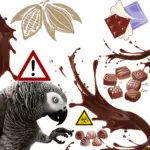
- Legumes are the dried seeds of pod plants, highly valued by our parrots, which come in various shapes and colors.
- Legumes are a premium source of vegetable protein and should be part of the parrot’s diet on a regular basis (3-4 times per week).
- Low in fat, cholesterol free (except peanuts) and rich in minerals.
- Legumes are listed in the “Meats and Alternatives” group in Canada’s Food Guide. 1 cup of legumes contains as much protein as 60 to 90 grams. of meat
- It is preferable to offer them to our bird in association with cereals and vegetables, not overcooked, “al dente”, but never dry.
- Mung and azuki beans, as well as lentils, are the most digestible legumes.
- All dried legumes can be stored for 1 year. Over time, legumes become harder and less digestible. It seems that this is less the case with lenses, but it is still better not to keep them for more than a year. They are kept in an airtight container, in a cool and dry place.
- Always offer legumes intended for human consumption to your parrot, never seeds intended for cultivation. In the latter case, the sanitary requirements are less strict and they may contain repellents or poisons for wild animals.
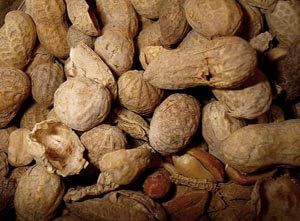
Peanuts
- Rich in calories and protein, very popular with our parrots. As peanuts are very rich, it is best to offer them in great moderation.
- More digestible dry roasted than raw.
- Commercial peanuts are usually roasted, whether shelled or in shell.
- Parrots love peanut butter. The latter should be kept cool, because it rancid easily.
- Avoid industrial peanut butters. They usually contain salt, chemical preservatives, flavorings and added sugars. In addition, often, to preserve their stability, hydrogenated oils (trans fats) are added to them.
Make peanut butter
Choose organic dry roasted peanuts and go through a blender ( food processor ).
It can be creamed with a little water.
Natural peanut butter ( no chemical preservatives )
Once started, will keep for one week at room temperature, two months in the refrigerator. In natural peanut butter, it is not uncommon for the oil to rise to the surface, a normal phenomenon that can be corrected by stirring everything with a knife.
Roasted peanuts
Roasted peanuts can be stored in a cool, dry place or in the refrigerator. Shelled, three months; in shell, nine months, and raw in an airtight container, three months in the refrigerator, six months in the freezer.
- Roast raw peanuts: arrange them in a single row on a metal sheet and roast for 15 to 20 minutes in an oven set at 175 ° C – 350 ° F
Boiled peanuts
Peanuts boiled in water acquire a soft texture that other cooking methods do not allow. Soak them overnight before cooking them over very low heat for eight to ten hours. Add water as needed. A treat very popular with parrots.
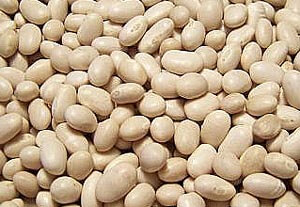
White beans
Beans
- Dried beans are one of the best dietary sources of soluble fiber and are high in good quality protein for our parrots.
- After picking, the skin of the beans hardens and certain chemical changes take place in the grain, which loses digestibility. The longer they are kept, the longer they must soak before being cooked.
- Semi-sprouted: soak them for eight hours. Then just put them, still wet, in a closed glass jar and place them in the dark. As soon as a germ appears, which takes about 24 hours, they can be cooked as usual.
- Dried beans can be stored for one year in an airtight container, in a cool, dry place. At the end of this time, they lose digestibility.

Azukis
A few beans
Azukis
- Good source of protein. Slightly sweet with a nutty taste, birds love it. Excellent sprouts and can also be puffed.
Black-eyed peacock
- The name of “black-eyed cowpea” comes from the fact that its hilum (point of attachment to the pod) forms a dark spot, usually black, sometimes brown, red or dark purple depending on the variety, which gives it the appearance with one eye. This hilum disappears on cooking.
Whites
- In the legume world, white beans are among the richest in calcium.
Mung
- It is mainly used sprouted; it is the basic ingredient of chop shuey. The most common variety is green, but there are over 200 others that can be golden yellow, brown, olive green, purplish brown, solid, or mottled.
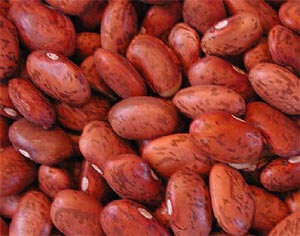
Pinto
Pinto
- Flecked bean, lightly salted and delicious.
- Warning: can create poisoning if poorly prepared. Refer to the “Preparation and Cooking” section at the bottom of this article.
Red
- Slightly floury and soft texture when cooked.
- Warning: can create poisoning if poorly prepared. Refer to the “Preparation and Cooking” section at the bottom of this article.
Soy
- Do not consume raw ( anti-trypsin ). Considered as rich as animal products. Avoid offering soy or its derivatives when the bird is in a hormonal period. Soy beans contain a natural form of estrogen which can increase hormone levels.
- Soy milk: lactose free, soy milk is suitable for parrots. Great source of calcium. Prefer soy milk fortified with vitamins A and D.
- Tofu: Drained and prepared, the milk gives tofu, a kind of vegetable cheese that has little flavor, but which can absorb that of other foods or condiments. Store in water in the refrigerator for 1 week.

Lentils
- Lentils are a good source of soluble fiber. These help stabilize blood sugar levels and provide energy over a long period.
- The reds are shelled, less nutritious and do not germinate. Lentils can lose their shape when cooked, so avoid cooking too long, which turns the lentils into a puree ( parrots don’t like it too much ). Allow 60 min for the brown lens, and 15 to 20 min for the red lens.
- Lentils do not need to be soaked Before cooking, rinse them with plenty of water, removing any floating ones… as well as pebbles if necessary.
- Plunging them in boiling water would aid their digestion.
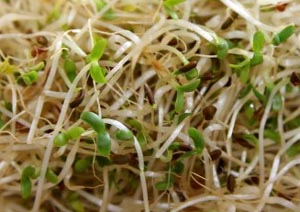
Alfalfa
- Very high nutritional value when sprouted. We find young shoots sold in grocery stores.
- The base of the shoots should be white and the tips green. They should be firm and cool. Avoid shoots that are yellow or withered or that are partially soaked in liquid.
- They are stored for a few days in the refrigerator in their original container or in a perforated plastic bag.
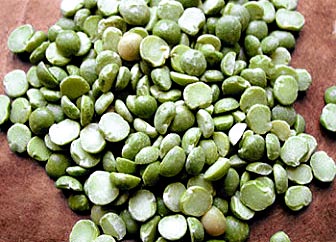
The peas
Chickpea
- It is the most protein of peas and the richest in minerals. Easy to germinate and delicious. Both desi and kabuli-type chickpeas germinate very well.
Dry peas, split peas, split peas
- Important source of protein and carbohydrates. Split peas have a more delicate taste and cook faster. May lose their shape when cooked.
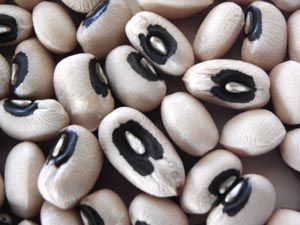
Black-eyed peacock
Preparation and cooking
If you buy canned legumes, you must take the time to rinse them well, as they are too salty for parrots.
Most varieties of legumes except Azukis, Mungs, and lentils need to soak for 6-8 hours or overnight, then need to boil over high heat for 15-20 minutes in order to flush out toxins. . This is especially important for the kidney bean family which can cause poisoning if not properly prepared.
- Always sort and wash all legumes thoroughly.
- Soak in a bowl large enough to let them swell if necessary ( see table below ). Cover with cold water, let soak overnight, then drain and rinse well.
- Always discard the legume soaking water ( trisaccharides – gases, toxic products )
- Start cooking the legumes in cold water, cover the legumes.
- Bring to a boil and boil over high heat 10 to 15 minutes.
- Then lower the heat and simmer over a lower heat, until tender.
- When cooked, legumes double or triple in size.
If you forgot to soak, you can put the legumes in cold water, bring to a boil for 2 minutes and let stand 2 hours so that they swell.
Legumes are an excellent source of protein for our parrots and should be offered on a regular basis, in combination with cereals, in the fruit and vegetable mixture of our birds.
Soaking and cooking table for legumes
| Legumes 1 cup |
Soak | Water | Cooking |
| Azukis | no | 3 cups | 1.5 hours |
| Black-eyed peacock | 6-8 hours | 3 cups | 1 hour |
| White beans | 6-8 hours | 3 cups | 1.5 hours |
| Black beans | 6-8 hours | 4 cups | 1 hour |
| Red beans | 6-8 hours | 3 cups | 1.5 hours |
| Soy beans | 24 hours | 3 cups | 2.5 hours |
| Lentils | no | 3 cups | 40-45 minutes |
| Red lentils | no | 3 cups | 20 minutes |
| Mung | no | 3 cups | 30 minutes |
| Pinto | 6-8 hours | 3 cups | 1.5 hours |
| Split peas | no | 3 cups | 5 minutes |
| Chickpeas | 6-8 hours | 4 cups | 2 hours |
| Yellow peas | 8 hours + | 3-4 cups | 3 hours |
Legumes for parrots
Hyacinth macaw parrot
•Legumes are the dried seeds of pod plants, much appreciated by our parrots, which come in various shapes and colors.
•Legumes are a source of premium vegetable protein and should be part of the parrot’s diet on a regular basis (3-4 times per week).
•Low in fat, cholesterol free (except peanuts) and rich in minerals.
•Legumes are listed in the “Meat and Alternatives” group of Canada’s Food Guide.- 1 cup of legumes contains as much protein as 60 to 90 grams. of meat
•It is preferable to offer them to our bird in association with cereals and vegetables, not overcooked, “al dente”, but never dry.
•Mung and aduki beans as well as lentils are the best digestible legumes.
•All dried legumes can be kept for 1 year. Over time, legumes become tougher and less digestible. It would seem that this is less the case for lentils, but it is still preferable not to keep them for more than a year. Keep them in an airtight container, cool and dry.
•Always offer legumes intended for human consumption to your parrot, never seeds intended for cultivation. In the latter case, the sanitary requirements are less strict and they may contain repellents or poisons for wild animals.
Peanuts for parrots
Peanuts
•Rich in calories and protein, much appreciated by our parrots. As peanuts are very rich, it is better to offer them in moderation.
•More digestible dry roasted than raw.
•Commercial peanuts are usually roasted, either shelled or in shell.
•Parrots love peanut butter. The latter must be kept cool, as it easily goes rancid.
•Avoid processed peanut butters. They usually contain salt, chemical preservatives, flavorings and added sugars. In addition, often, to preserve their stability, hydrogenated oils (trans fats) are added to them.
Make Peanut Butter
Choose organic dry roasted peanuts and blend in (robot).
It can be creamed with a little water.
Natural peanut butter (without chemical preservatives)
Once opened, can be kept for one week at room temperature, two months in the refrigerator. In natural peanut butter, it is not uncommon for the oil to rise to the surface, a normal phenomenon that can be corrected by stirring everything with a knife.
Roasted peanuts
Store roasted peanuts in a cool, dry place or in the refrigerator. Shelled, three months; in shell, nine months, and raw in an airtight container, three months in the refrigerator, six months in the freezer.
•Roast raw peanuts: arrange them in a single row on a metal baking sheet and roast for 15 to 20 minutes in an oven set at 175°C – 350°F Boiled peanuts
Peanuts boiled
in water acquire a soft texture that other cooking methods do not allow. First soak them overnight before cooking them over very low heat for eight to ten hours. Add water as needed. A popular treat for parrots.
White beans, calcium for parrots.
white
beans
•Dried beans are one of the best dietary sources of soluble fiber and are rich in good quality protein for our parrots.
•After picking, the skin of the beans hardens and certain chemical transformations occur in the grain, which loses digestibility. The longer they are kept, the longer they have to soak before being cooked.
•Semi-germinated: soak them for eight hours. Then just put them, still wet, in a closed glass jar and place them in the dark. As soon as a sprout appears, which takes about 24 hours, they can be cooked as usual.
•Dried beans can be stored for one year in an airtight container, in a cool, dry place. After this time, they lose digestibility.
Adzuki beans for parrots, lightly sweetened and nutty.
Azukis
Some Azuki beans
•Good source of protein. Slightly sweet with a nutty taste, birds love it. Excellent sprouted and can also be popped.
Black-eyed pea
•The name “black-eyed pea” comes from the fact that its hilum (point of attachment to the pod) forms a dark spot, usually black, sometimes brown, red or dark purple depending on the variety, which gives it the appearance of an eye. This hilum disappears on cooking.
White
beans
•In the world of legumes, white beans are among the richest in calcium.
mung
•It is mainly used sprouted; it is the basic ingredient of chop shuey. The most common variety is green, but there are over 200 others that can be golden yellow, brown, olive green, purplish brown, solid or mottled.
Pinto: lightly salted bean for parrots.
Pinto
•Speckled bean, lightly salted and delicious.
•Warning: can cause poisoning if poorly prepared. Refer to the “preparation and cooking” section at the bottom of this article.
Reds
•Slightly floury and soft texture once cooked.
•Warning: can cause poisoning if poorly prepared. Refer to the “preparation and cooking” section at the bottom of this article.
Soy
•Do not eat raw (anti-trypsin). Considered as rich as animal products. Avoid offering soy or its derivatives when the bird is in its hormonal period. Soy beans contain a natural form of estrogen which can increase hormone levels.
•Soy milk: Lactose-free, soy milk is suitable for parrots. Great source of calcium. Prefer soya milk enriched with vitamins A and D.
•Tofu: drained and prepared, the milk gives tofu, a sort of vegetable cheese which has little flavor, but which can absorb that of other foods or condiments. Can be kept in water in the refrigerator, 1 week.
Lentils, source of soluble fiber for our birds.
lentils
•Lentils are a good source of soluble fibre. These stabilize blood sugar levels and provide energy over a long period of time.
•Reds are peeled, less nutritious and do not germinate. Lentils can lose their shape when cooked, so avoid overcooking which turns the lentils into a puree (parrots don’t like it too much). Allow 60 min for the brown lentil, and 15 to 20 min for the red lentil.
•The lentils do not need to be soaked Before cooking them, rinse them with plenty of water, removing any that float… as well as stones if necessary.
•Plunging them into boiling water would aid their digestion.
Alfalfa for parrots, high nutritional value.
alfalfa
•Very high nutritional value when germinated. We find young shoots sold in grocery stores.
•The base of the shoots should be white and the tip green. They should be firm and fresh. Avoid shoots that are yellow or wilted or partially bathed in liquid.
•Keep them in the refrigerator for a few days in their original container or in a perforated plastic bag.
Dry, split or split peas, delicate taste.
Peas
Chickpeas
•This is the most protein-rich pea and the richest in minerals. Easy to sprout and delicious. Chickpeas of both the desi type and the kabuli type germinate very well.
Dry peas, split peas, split peas
•Important source of proteins and carbohydrates. Split peas have a more delicate taste and cook faster. May lose shape when cooked.
Black-eyed pea, a parrot bean.
Black-eyed pea
Preparation and Cooking
If you buy canned legumes, take the time to rinse them well, as they are much too salty for parrots.
Most legume varieties except Azukis, Mungs, and Lentils require soaking for 6-8 hours or overnight, then boil over high heat for 15-20 minutes to flush out toxins . This is especially important for the kidney bean family which can cause poisoning if not properly prepared.
•Always sort and wash all legumes carefully.
•Soak in a bowl large enough to let them swell if necessary (see table below). Cover with cold water, soak overnight, then drain and rinse well.
•Always discard the legumes soaking water (trisaccharides – gas, toxic products)
•Start cooking the legumes in cold water, cover the legumes.
•Bring to a boil and boil over high heat for 10 to 15 minutes.
•Then lower the heat and simmer over a lower heat, until they are tender.
•Cooked, legumes double or triple in volume.
If you forgot the soaking, you can put the legumes in cold water, bring to the boil for 2 minutes and leave to stand for 2 hours so that they swell.
Pulses are an excellent source of protein for our parrots and should be offered on a regular basis, along with grains, in our birds’ fruit and vegetable mix.
Legumes Soaking and Cooking Chart
Legumes 1 cup
Soak
Water
Cooking
Azukis
no
3 cups
1 ½ hours
Black-eyed peas
6-8 hours
3 cups
1 hour
White beans
6-8 hours
3 cups
1 ½ hours
Black beans
6-8 hours
4 cups
1 hour
Kidney beans
6-8 hours
3 cups
1 ½ hours
Soybeans
24 hours
3 cups
2 ½ hours
Lentils
no
3 cups
40-45 minutes
Red lentils
no
3 cups
20 minutes
Mung
no
3 cups
30 minutes
Pinto
6-8 hours
3 cups
1 ½ hours
Split peas
no
3 cups
45 minutes
Chickpeas
6-8 hours
4 cups
2 hours
Yellow peas
8 hours +
3-4 cups
3 heures
Related Articles:
- Foods That Parrots Should NOT Eat
- African grey food
- Parrot diet
- Parrot Nutrition and Diet
- What can’t parrots eat
- What do parrots eat in the wild
- Parrots feathers
- What vegetables can parrots eat
- What does a parrot eat

